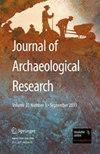在考古学中为网络寻找一席之地
IF 4.1
1区 历史学
Q1 ANTHROPOLOGY
引用次数: 42
摘要
正式的网络分析在考古学中有着悠久的历史,但最近才迅速兴起。网络模型借鉴了图论、社会网络分析和复杂性科学的方法,已被用于解决一系列关于网络结构、位置、个人和更大群体在一系列社会尺度上的属性和结果之间关系的广泛问题。目前的考古网络研究在方法和理论上都是多样化的,但使用考古数据对社会网络进行正式探索仍然面临许多艰巨的挑战。如果我们能够面对这些挑战,考古学家就能够在网络理论的本质、网络与文化之间的关系以及长期社会网络的动态等更广泛的网络研究领域中为长期存在的争论做出贡献。本文章由计算机程序翻译,如有差异,请以英文原文为准。
Finding a Place for Networks in Archaeology
Formal network analyses have a long history in archaeology but have recently seen a rapid florescence. Network models drawing on approaches from graph theory, social network analysis, and complexity science have been used to address a broad array of questions about the relationships among network structure, positions, and the attributes and outcomes for individuals and larger groups at a range of social scales. Current archaeological network research is both methodologically and theoretically diverse, but there are still many daunting challenges ahead for the formal exploration of social networks using archaeological data. If we can face these challenges, archaeologists are well positioned to contribute to long-standing debates in the broader sphere of network research on the nature of network theory, the relationships between networks and culture, and dynamics of social networks over the long term.
求助全文
通过发布文献求助,成功后即可免费获取论文全文。
去求助
来源期刊

Journal of Archaeological Research
Multiple-
CiteScore
10.20
自引率
7.90%
发文量
9
期刊介绍:
Journal of Archaeological Research publishes the most recent international research summaries on a broad range of topics and geographical areas. The articles are intended to present the current state-of-the-discipline in regard to a particular geographic area or specific research topic or theme. This authoritative review journal improves access to the growing body of information and literature through the publication of original critical articles, each in a 25-40 page format.2-Year Impact Factor: 4.056 (2017) 5-Year Impact Factor: 4.512 (2017)2 out of 85 on the Anthropology listIncluded in the European Reference Index for the Humanities (ERIH) PLUS The European Reference Index for the Humanities and the Social Sciences (ERIH PLUS) was created and developed by European researchers under the coordination of the Standing Committee for the Humanities (SCH) of the European Science Foundation (ESF). https://dbh.nsd.uib.no/publiseringskanaler/erihplus/about/indexSCImago Journal and Country Rank (SJR) 2018: 1.7102 out of 263 on the Archeology (Arts and Humanities) list3 out of 254 on the Archeology list2 out of 131 on the General Arts and Humanities listSJR is a measure of the journal’s relative impact in its field, based on its number of citations and number of articles per publication year.Source Normalised Impact per Paper (SNIP) 2018: 2.112The SNIP measures contextual citation impact by weighting citations based on the total number of citations in a subject field. The impact of a single citation is given higher value in subject areas where citations are less likely, and vice versa.CiteScore 2018: 3.86Rated ''A'' in the Australian Research Council Humanities and Creative Arts Journal List. For more information, visit: http://www.arc.gov.au/era/journal_list.htm
SCImago Journal and Country Rank (SJR) 2011 1.227 Archeology 1 out of 96 Archeology (Arts and Humanities) 1 out of 59 Arts and Humanities (miscellaneous) 1 out of 243
 求助内容:
求助内容: 应助结果提醒方式:
应助结果提醒方式:


